No products in the cart.
NEWS
Growing Tomatoes in Containers: Your Expert Guide to Patio Harvests
Even if your gardening space is limited to a patio, balcony, or small yard, the joy of picking sun-ripened tomatoes is entirely within reach. Growing tomatoes in containers is a wonderfully practical and rewarding way to cultivate these versatile fruits right at home. Unlike garden beds, pots offer flexibility, allowing you to create ideal growing conditions and place your plants in the sunniest spots available. Whether you’re a seasoned gardener or just starting out, mastering the art of growing tomatoes in pots opens up a world of fresh, flavorful possibilities.
Opting for containers provides significant advantages. You gain precise control over the soil composition, ensuring your plants have the perfect foundation for healthy growth. Potted plants are often easier to access for essential care tasks like watering, feeding, pruning, and adding support. And perhaps the greatest benefit? The sheer convenience of harvesting your delicious tomatoes just steps from your door. Let’s delve into how you can achieve bountiful tomato harvests from containers throughout the season.
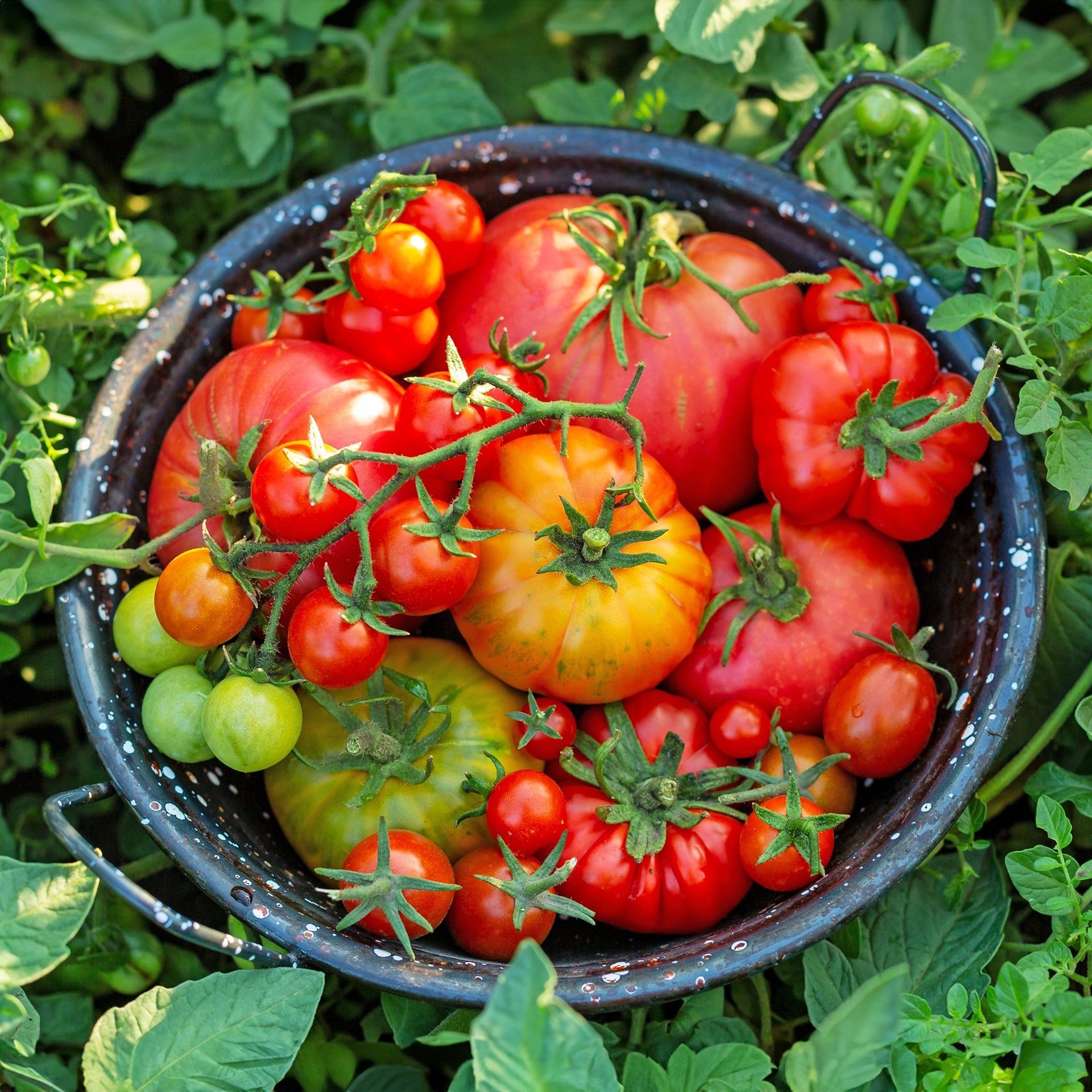 Freshly harvested ripe tomatoes sitting in a colander, showcasing the reward of growing your own.
Freshly harvested ripe tomatoes sitting in a colander, showcasing the reward of growing your own.
Choosing the Right Tomato Varieties for Containers
Success begins with selecting tomato types well-suited for container life. Understanding the two main growth habits is key: indeterminate and determinate.
Indeterminate tomatoes are vining types that grow continuously and produce fruit over a long season until frost. They can become quite tall (often 3-5 feet or more) and require substantial support like stakes, cages, or trellises, as well as regular pruning. While you can grow indeterminate varieties in large containers, they demand significant space and infrastructure.
Determinate tomatoes are generally the better choice for pots. These are bushy, more compact plants that reach a predetermined size, usually between 2 to 3 feet tall. They produce most of their fruit within a concentrated four-to-six-week period, making them ideal for harvesting all at once. Determinate varieties typically require less support and pruning compared to their indeterminate cousins.
Look for tomato types specifically labeled for containers, patios, or small spaces. Cherry and grape tomatoes are often excellent candidates due to their manageable size and prolific, sweet yields. When browsing for plants or seeds, keep an eye out for terms like “patio,” “compact,” “dwarf,” or “bush” – these usually indicate determinate varieties perfect for pots. While most heirloom varieties are indeterminate, the range of determinate options is constantly growing, offering delicious flavors and textures suitable for slicing, sauces, or snacking.
Selecting the Ideal Containers
The container you choose plays a crucial role in your tomato plant’s health and productivity. Fortunately, you have many options, from repurposed items to dedicated planters.
Common choices include 5-gallon buckets (ensure you drill drainage holes!), wooden barrels, or metal tubs. Wider containers are beneficial as tomato roots appreciate room to spread. Fabric grow bags are another popular choice; they are lightweight, promote air pruning of roots, and are easy to store when not in use. Don’t underestimate vertical space – growing tomatoes in hanging baskets can be a fun and space-saving technique, especially for cherry varieties.
Decorative pots made from glazed or unglazed clay, ceramic, or plastic can also work beautifully, adding aesthetic appeal to your growing space. Keep in mind that the material affects moisture retention: plastic and glazed ceramic pots hold water longer than porous terracotta.
Regardless of the type, the absolute most critical feature of any container for tomatoes is adequate drainage holes. Without them, soil can become waterlogged, leading to root rot and other problems.
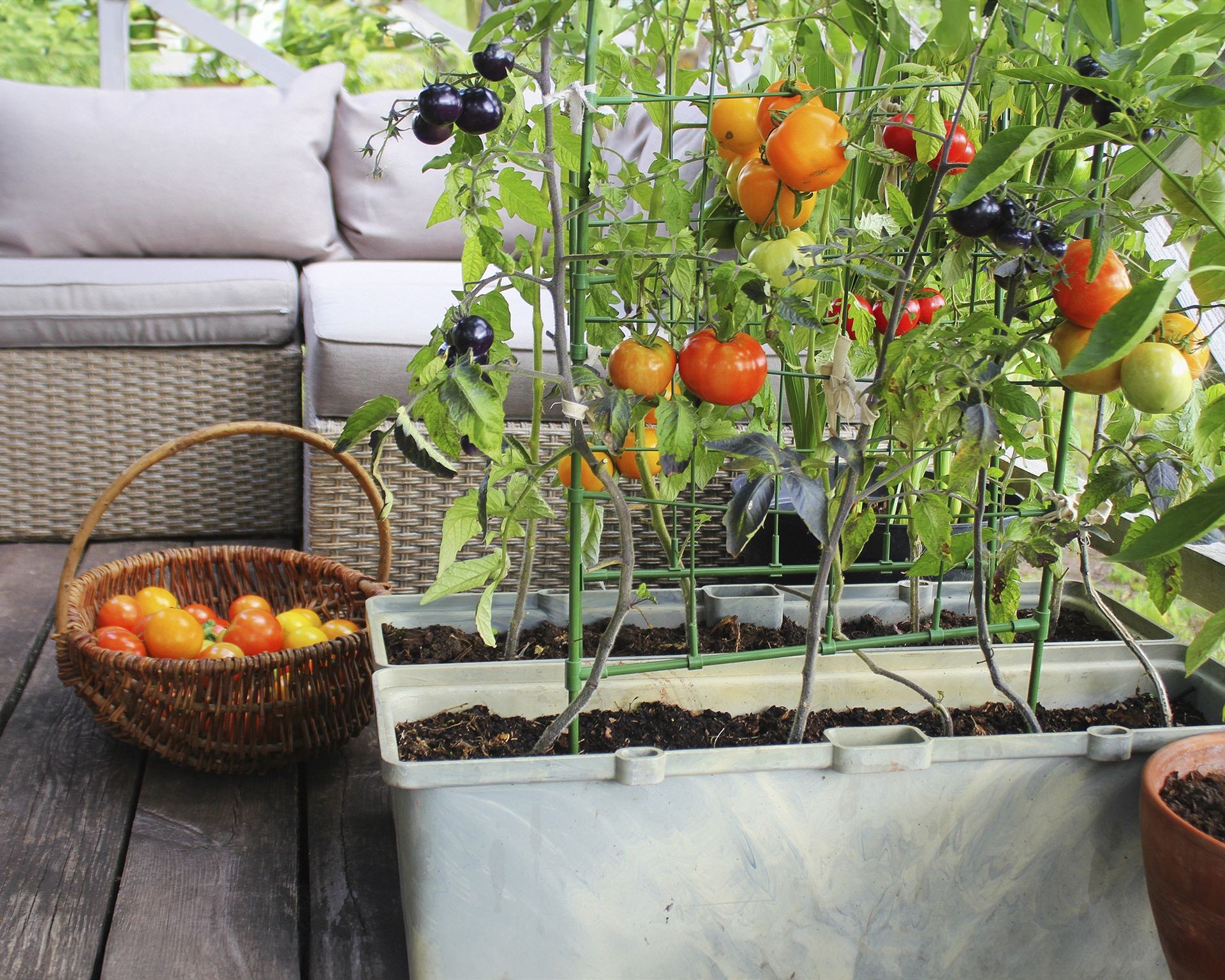 Various tomato plants thriving in large pots placed on a sunny garden deck.
Various tomato plants thriving in large pots placed on a sunny garden deck.
Determining the Right Container Size
When it comes to tomato container size, the general rule is: bigger is better. A generous pot provides ample space for root development, which directly correlates to plant vigor and fruit production.
Minimum recommendations typically call for containers at least 12 to 14 inches (30-35 cm) in diameter and 12 inches (30.5 cm) deep for most varieties. Each tomato plant needs at least 12 inches of surface area to thrive. Larger, more vigorous plants will benefit significantly from even bigger pots.
Using containers that are too small is a common pitfall. Small pots dry out much faster, requiring frequent watering. This not only ties you to constant watering duty but also washes away nutrients from the soil more quickly. Inconsistent moisture levels caused by small pots drying out are a leading cause of issues like blossom end rot (a dark, leathery spot on the bottom of the fruit) and fruit cracking. A larger pot helps buffer against these fluctuations, promoting healthier, more consistent fruit development.
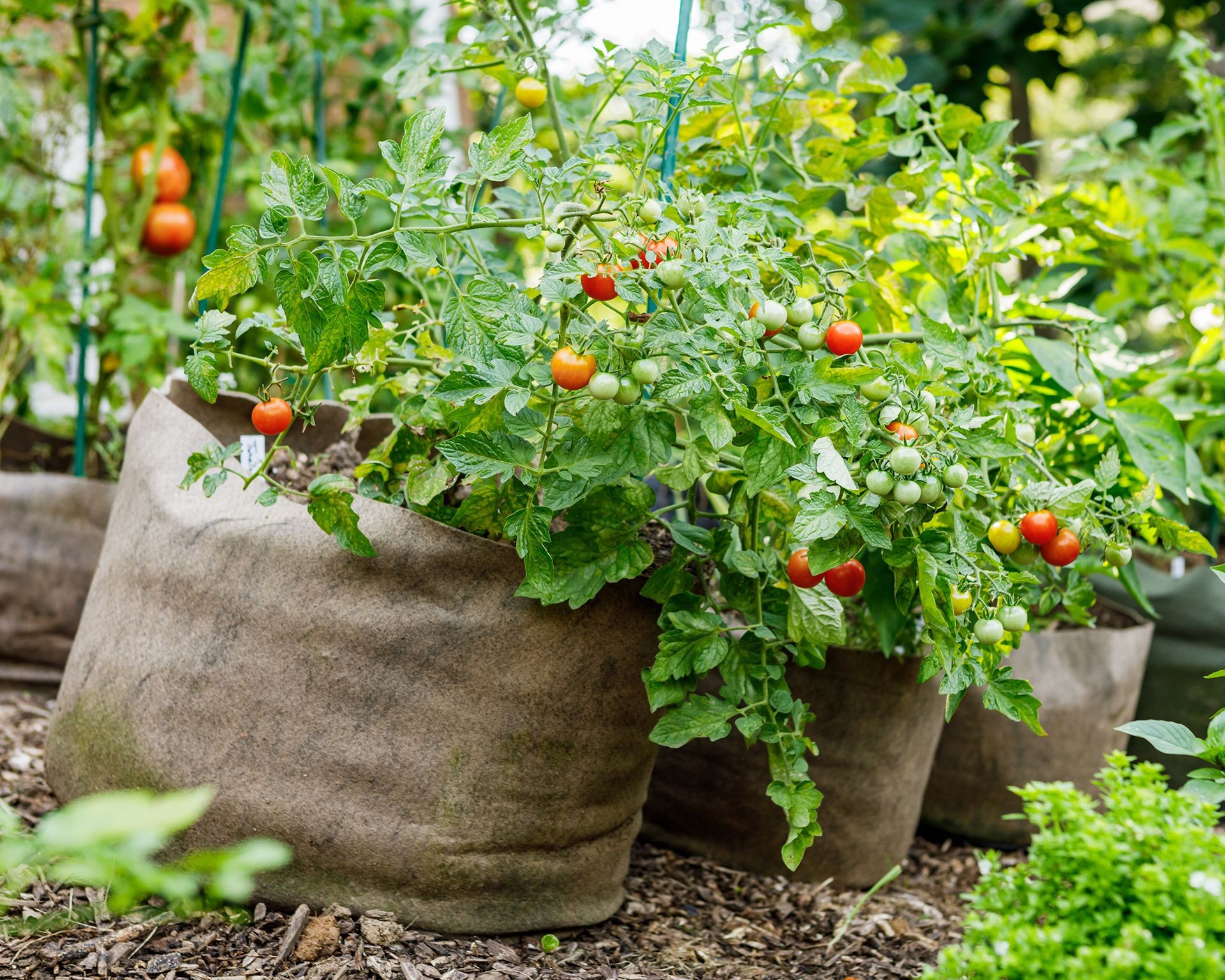 Healthy tomato plants growing vigorously in spacious fabric grow bags outdoors.
Healthy tomato plants growing vigorously in spacious fabric grow bags outdoors.
Starting Your Container Tomatoes
You have two primary paths to getting tomato plants into your containers: starting from seed or purchasing young plants (transplants).
Starting from seed is generally more cost-effective and offers access to a wider variety of cultivars. Begin sowing seeds indoors about five to six weeks before your average last frost date. Sow seeds in small pots or seed starting trays filled with a sterile seed starting mix. Covering the trays with a lid or plastic wrap helps maintain crucial humidity for germination. Providing gentle warmth from below using a seedling heat mat or simply placing trays in a warm location can speed up germination.
Once seedlings develop a few sets of true leaves and are a few inches tall, select the strongest ones to pot up into slightly larger containers. Before moving them permanently outdoors, it’s essential to “harden off” your seedlings. This process involves gradually exposing them to outdoor conditions (sun, wind, cooler temperatures) over a week or two to help them adapt and reduce transplant shock.
If you prefer a quicker and simpler approach, purchasing healthy tomato transplants from a local nursery or garden center is a great option. Look for compact, green plants with sturdy stems and no signs of yellowing leaves, spots, or pests.
Planting Tomatoes in Containers
Whether you started from seed or purchased transplants, the process of planting them into their final containers is largely the same.
Begin by filling your chosen container with a high-quality potting mix designed specifically for containers. Leave about 2 inches (5 cm) of space between the top of the soil and the rim of the pot; this space is needed for watering.
Gently remove your tomato plant from its temporary pot. If the roots are tightly coiled around the bottom (root-bound), gently loosen them with your fingers to encourage outward growth into the new soil. Watering the plant thoroughly before transplanting can ease its transition.
Dig a hole in the center of the potting mix large enough to accommodate the plant’s root ball. Place the plant in the hole, ensuring the roots are well-covered. You can actually plant tomato seedlings a bit deeper than they were in their original pot, as they will grow roots along the buried stem, creating a stronger root system.
Backfill the hole with potting mix, lightly pressing down to remove any large air pockets, but avoid compacting the soil too densely.
Once planted, place the container in its final sunny location. If you are growing a variety that requires support (especially important for indeterminate types), install the cage, stake, or trellis now, while the plant is young and before disturbing the roots becomes difficult.
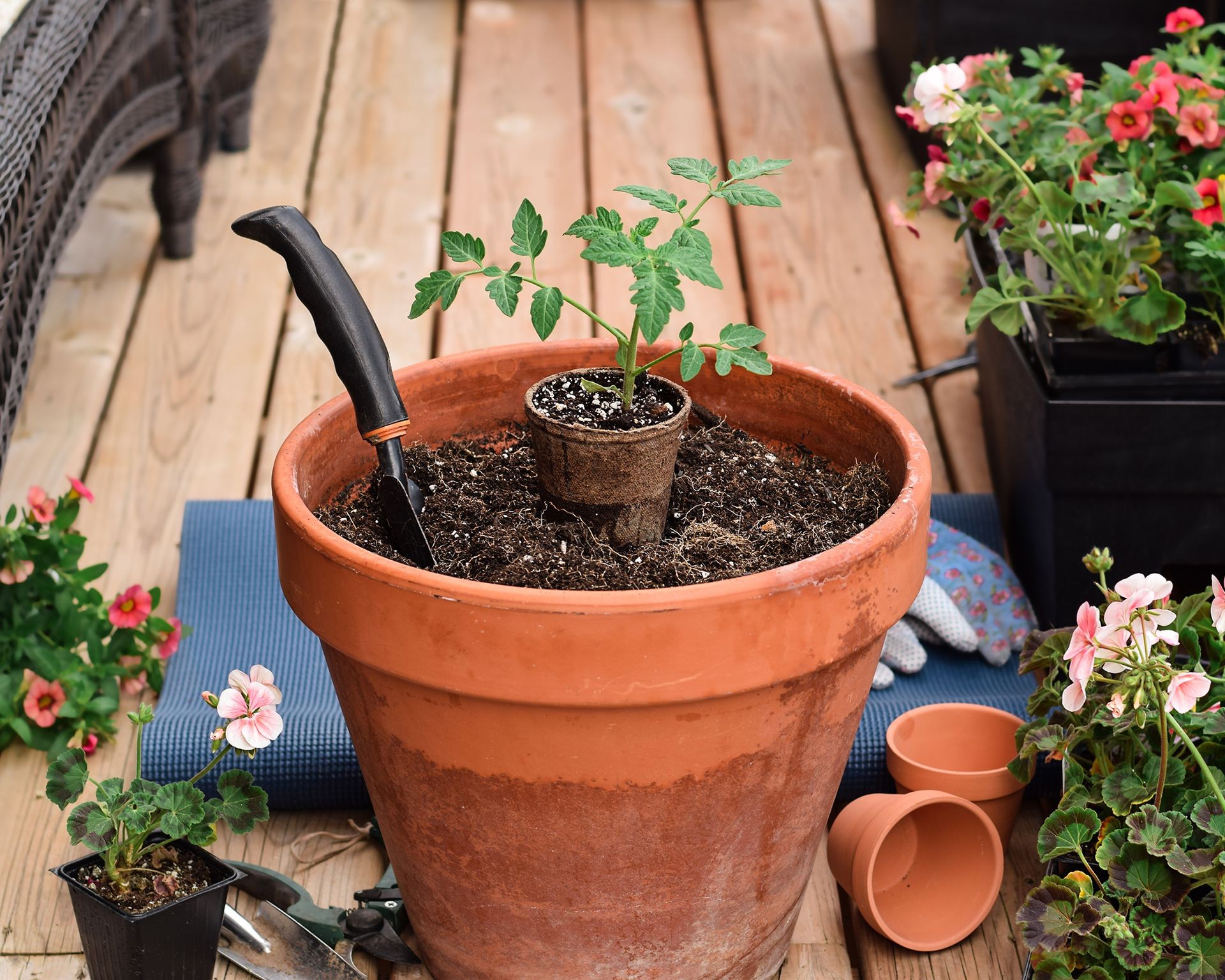 Hands carefully planting a young tomato seedling into a terracotta pot filled with potting mix.
Hands carefully planting a young tomato seedling into a terracotta pot filled with potting mix.
Expert Care Tips for Potted Tomatoes
Container-grown tomatoes need consistent care to thrive and produce abundantly. Meeting their basic needs for light, water, temperature, soil, and nutrients is paramount.
As an added layer of support for healthy growth and pest management, consider incorporating companion planting. Certain herbs and flowers planted in or near your tomato containers can help deter pests and attract beneficial insects like pollinators. Classic companions include basil and oregano, while marigolds and nasturtiums are popular floral choices known for their pest-repelling properties.
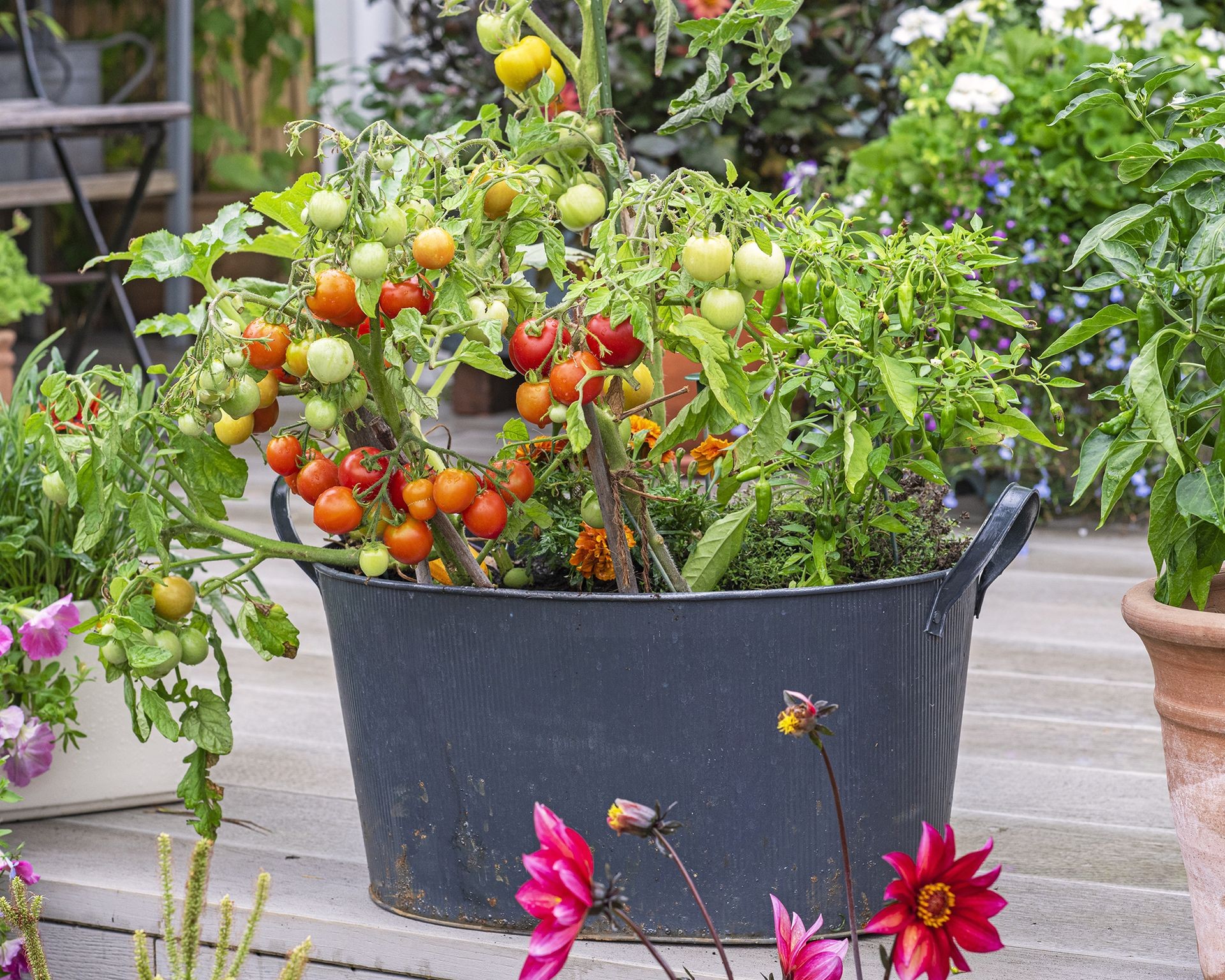 Container-grown tomato plants thriving alongside beneficial companion plants like marigolds and herbs.
Container-grown tomato plants thriving alongside beneficial companion plants like marigolds and herbs.
Light Requirements
Tomatoes are sun-lovers and require ample light to set fruit. For best results and maximum yield, position your containers where they will receive at least six hours of direct sunlight per day, with eight or more hours being ideal. A south or southwest-facing location typically offers the most intense sun exposure during the prime growing season.
Watering Container Tomatoes
Container plants, particularly tomatoes which are juicy fruits, dry out much faster than plants in the ground. Watering frequency depends heavily on weather, container size and material, but checking moisture levels daily is crucial. Poke your finger about two inches into the soil; if it feels dry, it’s time to water. In hot summer conditions, this could mean watering once or even twice a day.
Water deeply until you see water draining from the holes at the bottom. Aim to water the soil directly, avoiding getting the leaves wet, as this can encourage fungal diseases. Consistently moist soil is key; allowing the container to dry out completely between waterings stresses the plant and can cause issues like blossom end rot and flower drop. Applying a layer of mulch, such as straw or shredded bark, on top of the soil can help retain moisture and reduce the need for frequent watering.
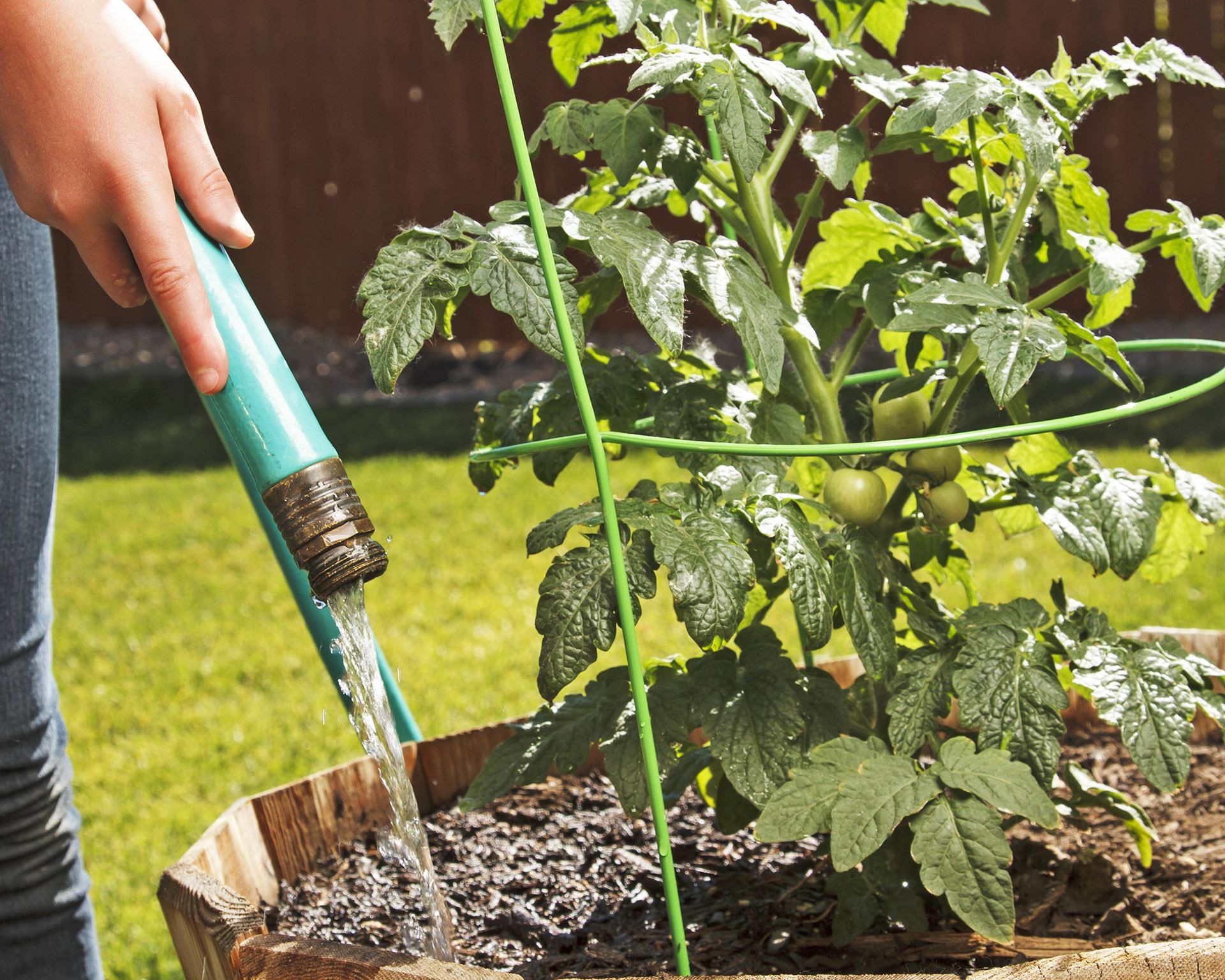 Hand watering a tomato plant growing in a container, providing essential moisture.
Hand watering a tomato plant growing in a container, providing essential moisture.
Temperature & Humidity
Tomatoes are warm-season plants and need sufficient heat to produce fruit. Ideal daytime temperatures for growth range from 70-82°F (21-27°C), while nighttime temperatures should ideally stay between 62-64°F (17-18°C). If unexpected cold snaps threaten towards the end of the season, covering your plants with frost protection fabric at night can help extend the harvest. Very high humidity can sometimes interfere with pollination, though this is less common in typical outdoor container settings. An optimal humidity range is generally considered to be 65-85%.
Soil for Containers
Using the correct soil mix is fundamental. Potted plants need a mix that is light, well-draining, yet capable of retaining some moisture. A quality potting mix specifically formulated for containers is essential – garden soil is too heavy and compacts easily in pots. The mix should ideally be slightly acidic. You can enhance the drainage and nutrient content by incorporating organic matter like compost.
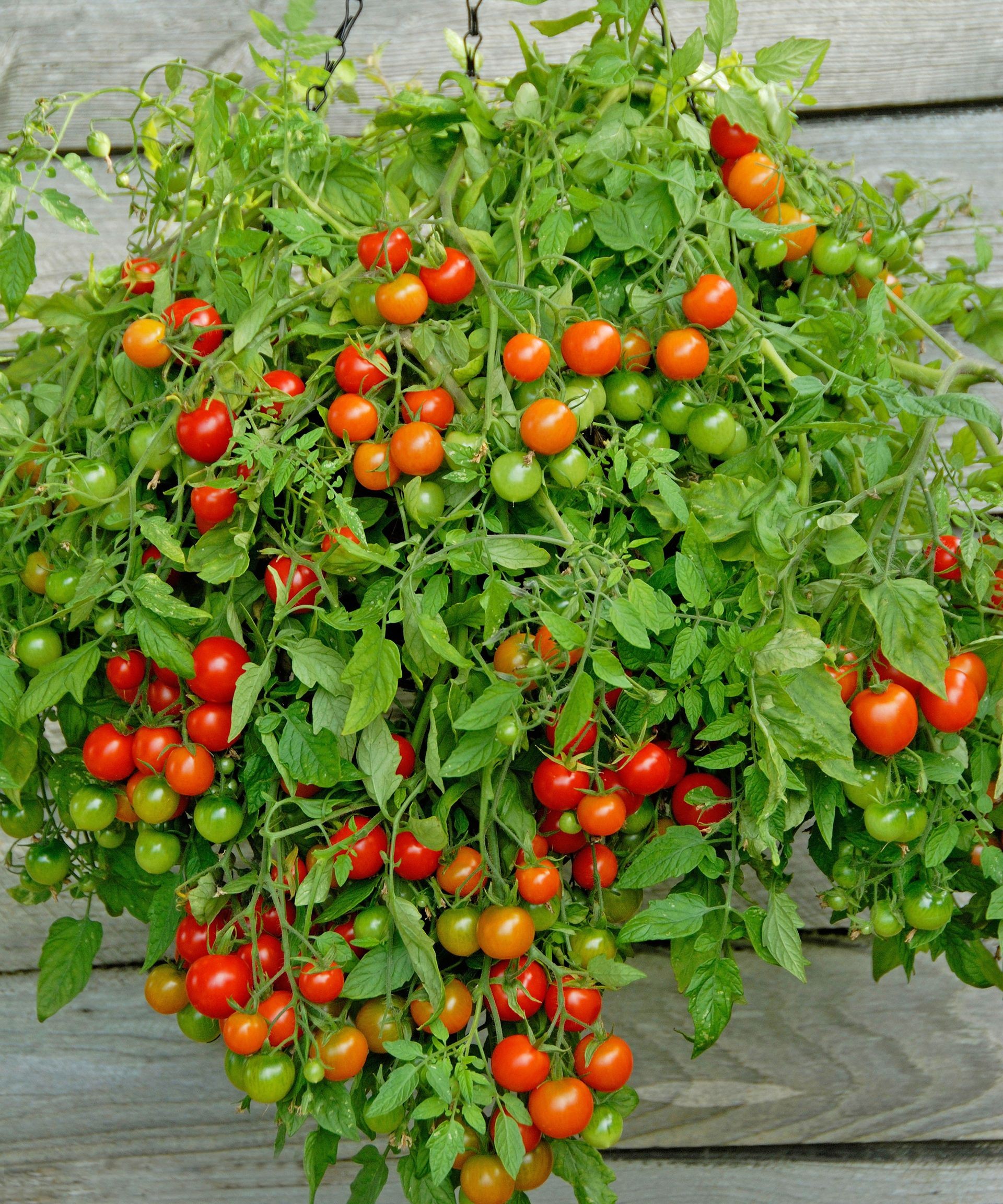 Ripe tomatoes hanging and spilling over the edges of a lush hanging basket container.
Ripe tomatoes hanging and spilling over the edges of a lush hanging basket container.
Fertilizing Container Tomatoes
Tomatoes are heavy feeders, requiring a consistent supply of nutrients to fuel their growth and fruit production. Start with an enriched potting mix containing some slow-release fertilizer or compost. You can begin feeding with a starter fertilizer at planting time to support root and early leaf development.
Once the plant begins to flower and set fruit, switch to a liquid feed applied every two to three weeks. Choose a fertilizer formulated for tomatoes or vegetables, often one with a lower first number (Nitrogen) and higher middle number (Phosphorus) to encourage flowering and fruiting rather than just leafy growth. Container plants need more frequent feeding than in-ground plants because nutrients leach out of the soil more readily with watering. Always water the plant well before applying liquid fertilizer to avoid burning the roots. Applying fertilizer in the morning allows the plant to readily absorb the nutrients throughout the day.
Providing Support for Container Tomatoes
While compact, determinate varieties might need minimal to no support, more vigorous bush types and especially vining indeterminate tomatoes will definitely require help to stay upright as they become laden with fruit. Supporting the plant prevents sprawling, keeps fruit off the ground (reducing disease risk), and improves air circulation.
Tomato cages are a common and effective option, readily available in sizes suitable for containers. It’s easiest to place the cage around the young plant at planting time. Stakes are another method; insert sturdy stakes into the pot and gently tie the main stems to them as the plant grows. A trellis placed behind or within the container can also work, requiring you to train and tie stems to its structure.
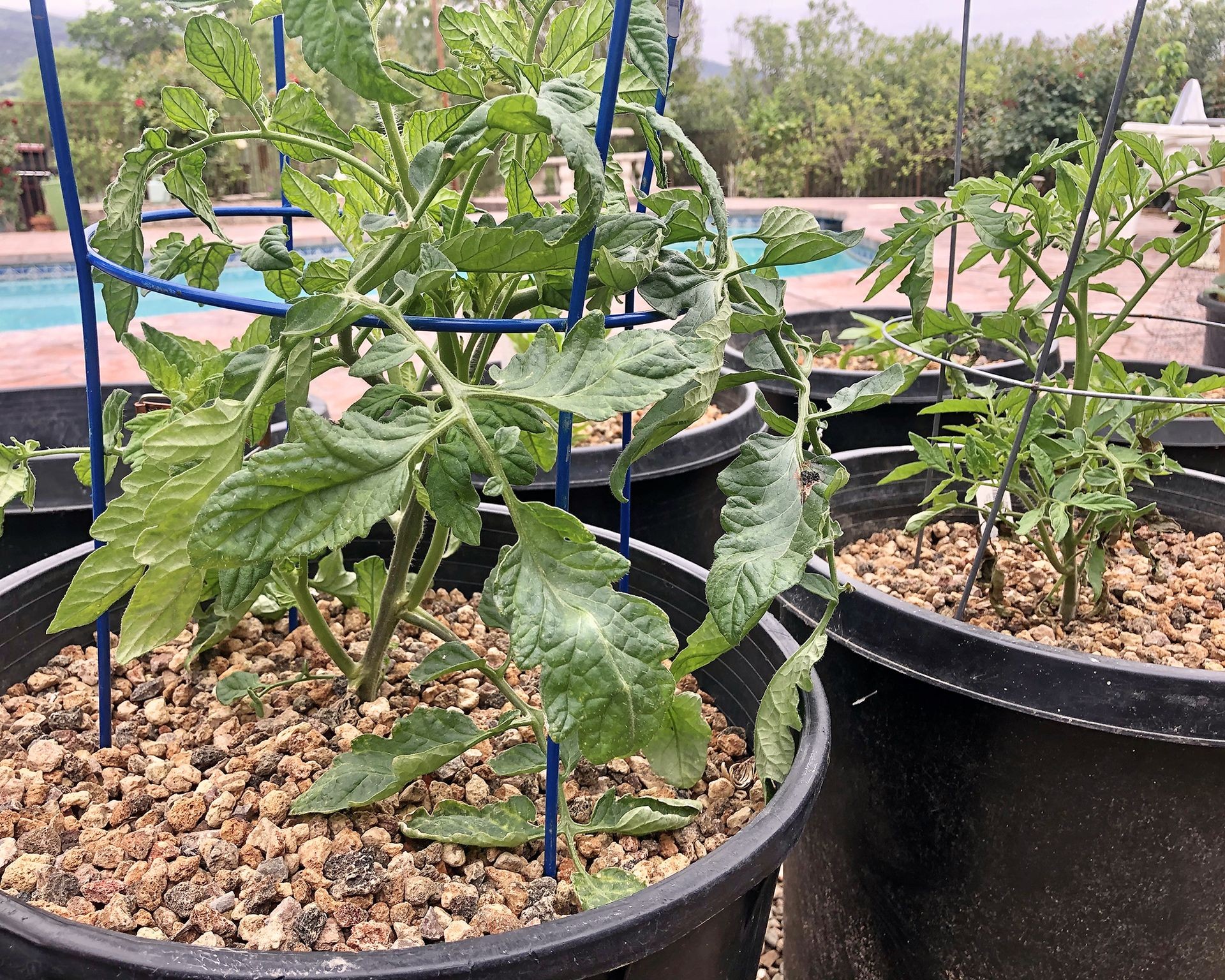 Tomato plants supported by metal cages within large containers, ensuring upright growth and fruit development.
Tomato plants supported by metal cages within large containers, ensuring upright growth and fruit development.
Harvesting Your Container Tomato Bounty
The exciting time of harvest arrives when your tomatoes are plump, glossy, have reached their full color for the variety, and feel slightly soft when gently squeezed. The harvest period varies depending on the tomato type: determinate varieties tend to ripen their fruit within a shorter window, while indeterminate types will continue producing until stopped by cold weather.
Pick ripe tomatoes by gently twisting or snipping the stem just above the fruit. If cool weather is predicted and you have green tomatoes on the vine, you can harvest them and ripen them indoors. Place them in a paper bag with an apple or banana (which release ethylene gas, prompting ripening) and store in a cool, dark place until they turn red.
Managing Pests, Diseases, and Common Issues
Even with the best care, container tomatoes can encounter problems. Common issues often stem from improper watering (over or under), lack of adequate sunlight, insufficient nutrients, or lack of support.
Pests can also find your potted tomatoes appealing. Keep a close eye on your plants. Larger pests like tomato hornworms can often be spotted and removed by hand. For smaller sucking insects like aphids, a strong spray of water or applying a natural insecticidal soap solution can be effective. Row covers can be used to protect young plants from flying insects that lay eggs.
Many common tomato diseases can be prevented with good practices: always use fresh, sterile potting mix at the start of the season, choose disease-resistant tomato varieties when possible, and practice proper watering techniques by watering the soil base and keeping leaves dry, which discourages fungal growth. Ensuring good air circulation around the plant also helps prevent disease.
Following these expert tips will set you on the path to enjoying a prolific harvest of fresh, delicious tomatoes grown right in containers on your patio or balcony.
By applying the principles of container gardening and providing consistent care, you can successfully cultivate vibrant tomato plants and enjoy the unparalleled flavor of home-grown fruit throughout the season. Whether you’re starting with a few pots or transforming your entire outdoor space, growing tomatoes in containers is a rewarding endeavor accessible to nearly everyone. Get started on your container tomato journey and taste the difference fresh makes! Biogarden.Asia offers a range of quality potting mixes, fertilizers, and gardening supplies to support your success.



